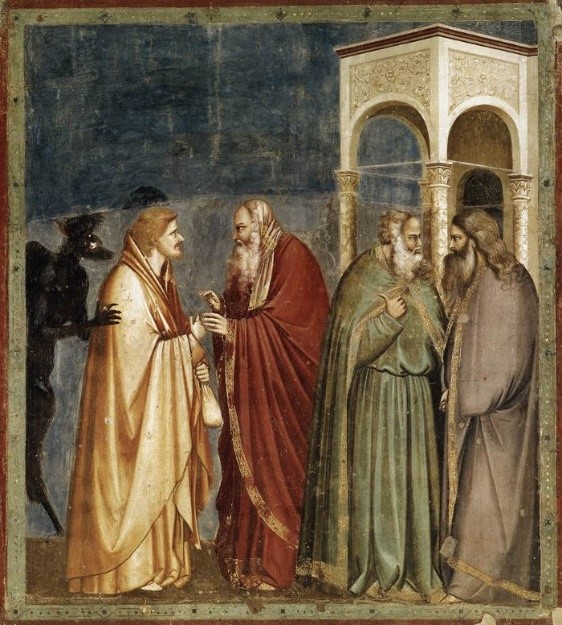Then one of the twelve, who was called Judas Iscariot, went to the chief priests and said, “What are you willing to give me if I deliver him to you?” So they weighed out for him thirty pieces of silver. From that time he sought opportunity to betray him.
Matthew 26:14-16
Giotto’s masterful frescos in the Scroveigni chapel are often regarded as an example of the transition between Medieval art and Renaissance art. Medieval art is mostly flat, stylized, and full of symbols and ornate decoration. At best, it feels otherworldly, like a translation of supernatural truths too wonderful for normal perception. At worst, it is full of wonky-faced madonnas and creepy old-man-looking babies. Renaissance art is all about Greek-influenced naturalism and visual beauty and balance. Space is three-dimensional, and figures feel real. Giotto’s painting clearly has aspects of both; here is a sense of naturalism and realism remarkable for its time as the figures are individualized and three-dimensional. It feels like there are real bodies under the carefully painted cloaks and drapery. There is also knowledge of perspective in the architecture, and the way figures are overlapped and arranged.
But there is a very medieval air of seriousness and mystery, and not just because the faces are a little wonky sometimes. Giotto’s use of color throughout is very medieval. He uses bright, saturated, pure, intentional, symbolic colors. The deep lapis lazuli blue of the vaulted heavenly ceiling above is the dominant color in the chapel and is the same blue for the background of every panel (see image below). It is not a daytime sky or nighttime sky, but more like a symbolic atmosphere of depth and divinity throughout all of the paintings. Another color choice in this specific panel is yellow. Judas is often depicted wearing yellow in this time period because yellow represented jealousy. Was it jealousy that drove him to betray Jesus? Was he jealous of the other disciples, that Jesus seemed to love them more or that they had better faith than him? Was he jealous of others in his life who were wealthier or more successful, and he wanted to be like them, and that is why he stole from the money bag and betrayed his friend for some pieces of silver? Was he jealous of Jesus? Of Jesus’ fame, wisdom, or leadership? All sin, at its root, is jealousy over lordship… we want to be in charge, not submit to God. That is why satan was cast out; he wanted to be like God. And that first jealousy of satan is what is really propelling all of these events forward, just as Giotto depicts him propelling Judas forward, a very medieval-looking, hideous-yet-pitiful shadowy figure. But God, in His great power uses even the sins of men and the machinations of the devil to fulfill His purpose to defeat sin and satan once and for all and bring His children back to Himself.
